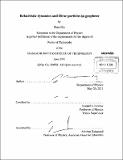Relativistic dynamics and Dirac particles in graphene
Author(s)
Gu, Nan, Ph. D. Massachusetts Institute of Technology
DownloadFull printable version (8.053Mb)
Other Contributors
Massachusetts Institute of Technology. Dept. of Physics.
Advisor
Leonid S. Levitov.
Terms of use
Metadata
Show full item recordAbstract
Graphene, a two-dimensional hexagonal lattice of carbon, has jumped to the forefront of condensed matter research in the past few years as a high quality two-dimensional electron system with intriguing scientific and practical applications. Both the monolayer and bilayer allotropes are of tremendous theoretical interest, each in its own specific ways. We will focus on the transport properties of graphene in various gated configurations and magnetic fields. We proceed by stating the motivations to study these unusual materials and follow up by deriving the machinery needed to model and understand the low energy behavior. We will see that graphene offers many very strange and unexpected phenomena. We will begin with monolayer in crossed electric and magnetic fields and use the Lorentz symmetry of the Dirac equation to solve for magnetoconductance. Next, we proceed to study monolayer quasiparticles in a deconfining potential and a magnetic field. The twodimensional nature of graphene allows us to study competition between the two external fields. Finally, a look at bilayer graphene in a p-n-p junction shows a case of confinement by chirality - where transitions between states at the same energy are forbidden by an emergent quantum property, chirality. The purpose of this thesis is to provide a taste of the bizarre possibilities that occur in graphene, and to convince the reader that graphene really is unique and worthy of detailed study. The general writing philosophy is to use toy models to provide a simple intuitive picture, followed by a more quantitative analysis.
Description
Thesis (Ph. D.)--Massachusetts Institute of Technology, Dept. of Physics, 2011. Cataloged from PDF version of thesis. Includes bibliographical references (p. 85-90).
Date issued
2011Department
Massachusetts Institute of Technology. Department of PhysicsPublisher
Massachusetts Institute of Technology
Keywords
Physics.